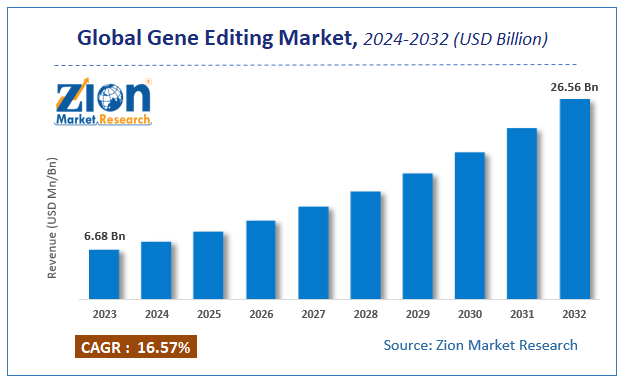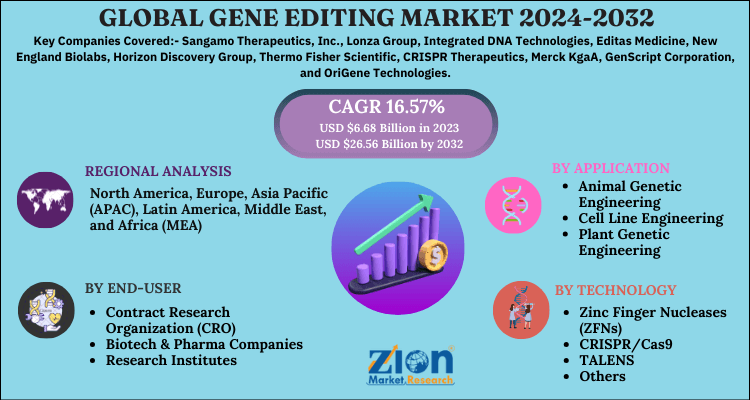Gene Editing Market Size, Share, Trends, Growth and Forecast 2032

Gene Editing Market - By Application (Animal Genetic Engineering, Cell Line Engineering, Plant Genetic Engineering, and Others), By End-User (Contract Research Organization (CRO), Biotech & Pharma Companies, and Research Institutes), By Technology (Zinc Finger Nucleases (ZFNs), CRISPR/Cas9, TALENS, and Others), and By Region - Global Industry Perspective, Comprehensive Analysis, and Forecast, 2024 - 2032
| Market Size in 2023 | Market Forecast in 2032 | CAGR (in %) | Base Year |
|---|---|---|---|
| USD 6.68 Billion | USD 26.56 Billion | 16.57% | 2023 |
Global Gene Editing Market Insights
According to Zion Market Research, the global Gene Editing Market was worth USD 6.68 Billion in 2023. The market is forecast to reach USD 26.56 Billion by 2032, growing at a compound annual growth rate (CAGR) of 16.57% during the forecast period 2024-2032.
The report offers a comprehensive analysis of the market, highlighting the factors that will determine growth, potential challenges, and opportunities that could emerge in the Gene Editing industry over the next decade.
The report offers assessment and analysis of the gene editing market on a global and regional level. The study offers a comprehensive assessment of the market competition, constraints, sales estimates, opportunities, evolving trends, and industry-validated data. The report offers historical data from 2018 to 2023 along with a forecast from 2024 to 2032 based on revenue (USD Billion).
Introduction
Gene editing is assisting in transformation of basic research in the life sciences and is projected to find plethora of applications in human & animal health, farming & food systems, and the bio-economy. Today, scientists can modify sequences of DNA through insertion or deletion of genes in cells of living organisms. Apparently, the current gene editing methods are safe, effective, and cost-effective and hence have found applications in array of industries. Specifically, two nuclease-based gene-editing technologies, TALE and CRISPR, help scientists to edit genomes with extraordinary precision in a shorter duration. Moreover, these gene editing techniques have provided exact & regulated was for changing crop & animal traits. Furthermore, nuclease-based gene editing is likely to bring revolution in agriculture sector and increase crop yield.
Furthermore, researchers are trying to modify immune cells or T-cells for preventing them from getting infected due to HIV. Scientists are developing various kinds of gene editing methods for treating hemophilia, and engineer T-cells to target & destroy cancer tissues.
Market Growth Drivers
Gene editing is creating a paradigm shift in biotechnology domain. Reportedly, gene editing techniques like CRISPR has the capability of influencing the fields of personalized medicine, cancer research, and healthcare. This, in turn, will built a strong platform for the growth of gene editing market within a span of next few years. Furthermore, gene editing is also used for disease modelling in human beings as well as in gene therapy. It is also utilized for treating heart ailments, viral diseases, inherited eye disorders, hematological ailments. In future, it is also possible to use gene editing tools in cancer immunotherapy, gene diagnostics, and screening of functional genes.
In nuclease-based gene editing, nucleases are used to edit genes. Apparently, nuclease-based gene editing technique finds a slew of applications in the field of biotechnology and is used widely in research & genetic trials as it is cost-effective, easy to perform, and fast. Reportedly, since last few years, TALEN and CRISPR nucleases have enhanced the speed and lowered the cost of gene editing procedures to a larger extent. They have been one of the most vital breakthroughs in the gene editing technologies and are likely to find massive utilization in medical, healthcare, and farming activities. This, in turn, will not only open new vistas of growth for nuclease-based gene editing market, but will favorably influence the gene editing industry over a long run.
Furthermore, nuclease-based gene editing is already being developed for human therapeutics, as a new approach to perform gene therapy and introducing or editing genes to cure diseases. Reportedly, growing progress in creation of programmable nucleases like zinc-finger nucleases, transcription activator-like effector nucleases or TALENs, and Cas9-related nucleases is projected to expedite the growth of gene editing market over the forecast timeline. Apparently, their derivative agents are used as gene editing tools for treating myriad human diseases.
Other very potential gene editing approaches are being developed in the field of immuno-oncology with engineered CAR-T cells directing immune system to fight and eliminate cancer cells. There is an extensive array of potential uses of gene editing techniques in biosynthesis of pharmaceuticals, biofuels, other high-value chemicals, biosensors, bioremediation, and in the food chain. Innovation in the bioeconomy will further augment the gene editing business growth in the near future.
According to the results presented by CRISPR Therapeutics & Vertex Pharmaceuticals before European Hematology Association in June 2020, it was demonstrated that two patients affected due to beta thalassemia and one subject suffering from sickle cell disorder did not require transfusion of blood after their stem cells in the bone marrow were gene edited by using CRISPR technique. This breakthrough is likely to encourage the development of new gene editing therapies for treating various kinds of hereditary diseases in the foreseeable future.
As per NCBI, most clinical utilization of CRISPR gene editing techniques has highlighted on ex vivo gene edition of cells succeeded by the re-introduction of these gene-edited cells again into the subject. The ex vivo editing method has proved to be highly effective for treating many diseases including cancers and sickle cell. However, gene editing can also be applied to diseases requiring cell alteration in vivo.
Moreover, with the rapid evolution of new gene editing procedures, long-lasting or permanent alleviation of genetic disorders through selective modifying of the human genes may become a possibility in the near future, thereby generating huge potential for not only enhancing human health, but also the lifespan of the human beings.
Global Gene Editing Market: Segmentation
The study provides a decisive view of the gene editing market by segmenting the market based on by application, by end-user, by technology, and by region. All the segments have been analyzed based on present and future trends and the market is estimated from 2024 to 2032.
By application type segment analysis includes Animal Genetic Engineering, Cell Line Engineering, Plant Genetic Engineering, Others.
By nd-User segment analysis includes Contract Research Organization (CRO), Biotech & Pharma Companies, Research Institutes.
By technology type segment analysis includes Zinc Finger Nucleases (ZFNs), CRISPR/Cas9, TALENS, Others.
The regional segment includes the current and forecast demand for North America, Europe, Asia Pacific, Latin America, and the Middle East and Africa.
Gene Editing Market: Report Scope
| Report Attributes | Report Details |
|---|---|
| Report Name | Gene Editing Market |
| Market Size in 2023 | USD 6.68 Billion |
| Market Forecast in 2032 | USD 26.56 Billion |
| Growth Rate | CAGR of 16.57% |
| Number of Pages | 110 |
| Key Companies Covered | Sangamo Therapeutics, Inc., Lonza Group, Integrated DNA Technologies, Editas Medicine, New England Biolabs, Horizon Discovery Group, Thermo Fisher Scientific, CRISPR Therapeutics, Merck KgaA, GenScript Corporation, and OriGene Technologies |
| Segments Covered | By Application, By End-User, By Technology, And By Region |
| Regions Covered | North America, Europe, Asia Pacific (APAC), Latin America, Middle East, and Africa (MEA) |
| Base Year | 2023 |
| Historical Year | 2018 to 2022 |
| Forecast Year | 2024 - 2032 |
| Customization Scope | Avail customized purchase options to meet your exact research needs. Request For Customization |
North America To Dominate Overall Market Expansion Over 2024-2032
The growth of the market in North America during the period from 2023 to 2032 is credited to massive acceptance of new gene editing methods in the research institutions in the countries like the U.S. Moreover, favorable laws in the countries like U.S. encouraging gene editing research activities will boost the regional market growth.
Key players influencing market growth include-
- Sangamo Therapeutics
- Lonza Group
- Integrated DNA Technologies
- Editas Medicine
- New England Biolabs
- Horizon Discovery Group
- Thermo Fisher Scientific
- CRISPR Therapeutics
- Merck KgaA
- GenScript Corporation
- OriGene Technologies.
The global gene editing market is segmented as follows:
By Application
- Animal Genetic Engineering
- Cell Line Engineering
- Plant Genetic Engineering
- Others
By End-User
- Contract Research Organization (CRO)
- Biotech & Pharma Companies
- Research Institutes
By Technology
- Zinc Finger Nucleases (ZFNs)
- CRISPR/Cas9
- TALENS
- Others
By Region
- North America
- The U.S.
- Canada
- Europe
- France
- The UK
- Spain
- Germany
- Italy
- Rest of Europe
- Asia Pacific
- China
- Japan
- India
- South Korea
- Southeast Asia
- Rest of Asia Pacific
- Latin America
- Brazil
- Mexico
- Rest of Latin America
- Middle East & Africa
- GCC
- South Africa
- Rest of Middle East & Africa
Table Of Content
Methodology
FrequentlyAsked Questions
There is an extensive array of potential uses of gene editing techniques in biosynthesis of pharmaceuticals, biofuels, other high-value chemicals, biosensors, bioremediation, and in the food chain, thereby driving the Gene Editing Market by 2032
(CAGR) of 16.57% during the forecast period 2024-2032.
North America will contribute remarkably towards the global market share over the estimated timeline.
The key market players include New England Biolabs, Thermo Fisher Scientific, CRISPR Therapeutics, Merck KgaA, GenScript Corporation, Sangamo Therapeutics, Inc., Editas Medicine, Integrated DNA Technologies, Lonza Group, Horizon Discovery Group, and OriGene Technologies.
Choose License Type
RelatedNews
HappyClients
Zion Market Research
Tel: +1 (302) 444-0166
USA/Canada Toll Free No.+1 (855) 465-4651
3rd Floor,
Mrunal Paradise, Opp Maharaja Hotel,
Pimple Gurav, Pune 411061,
Maharashtra, India
Phone No +91 7768 006 007, +91 7768 006 008
US OFFICE NO +1 (302) 444-0166
US/CAN TOLL FREE +1 (855) 465-4651
Email: sales@zionmarketresearch.com
We have secured system to process your transaction.
Our support available to help you 24 hours a day, five days a week.
Monday - Friday: 9AM - 6PM
Saturday - Sunday: Closed







